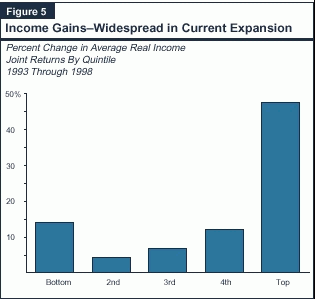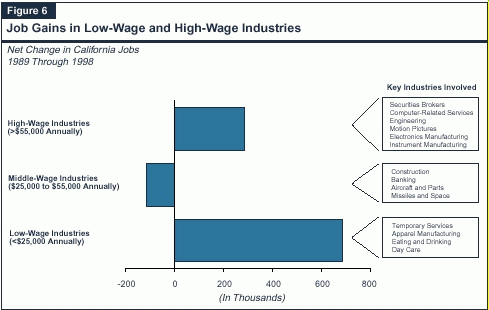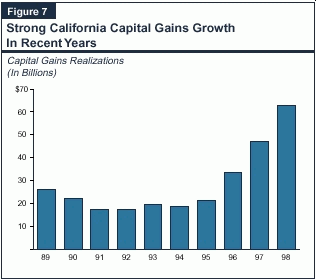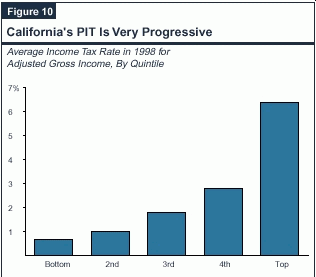
 |
California's
|
Background |
A much-publicized issue in California has been the widening gap in income received by low-income versus high-income households during the past several decades. This report uses California tax return data compiled between 1975 and 1998 to examine the changes in California's income distribution and their causes. | |
LAO Findings |
|
A much-publicized issue in recent years at both the national and state levels has been the change in the distribution of income. Numerous studies have documented a widening gap in earnings reported by low-income versus high-income households during the past several decades, with the growth in income inequality being larger in California than the rest of the nation. There has been considerable debate about both the causes and significance of this growing inequality, whether it will continue to widen in the future, and what should be done about it.
In this report, we look at the extent to which distributional changes are evident in income reported on California income tax returns. Tax return
data provide rich detail on the distribution of income and, unlike other sources, include information on capital gains--a particularly significant
contributor to the shift toward inequality in recent decades (see accompanying shaded box). We also look at some of the key factors responsible
for the shift, using historical employment and industry wage data for California. Finally, we discuss some of the fiscal-related implications of
greater income inequality.
Different Ways of Measuring the Income DistributionIncome distribution studies normally rely on one of two data sources, both of which share certain limitations and each of which offers its own advantages and disadvantages. The first data source is the Current Population Survey (CPS), which is a national survey conducted annually by the U.S. Census Bureau of 50,000 households (of which about 5,000 are located in California). The second is taxpayer data, drawn from either federal or state samples of personal income tax returns. In California, the Franchise Tax Board's annual state file is based on a sample of 85,000 tax returns, and this is the data used in this analysis. Limitations of the CPS and Tax Data A frequent concern voiced about both CPS and taxpayer data is that neither provides a comprehensive measure of household income. Neither includes, for example, the noncash employer-provided benefits that households receive such as health insurance, 401-K funding, or pension contributions. Nor do they include noncash public benefits, such as housing assistance, Medi-Cal, or food stamps. Furthermore, in both cases, household incomes are measured on a pre-tax, versus after-tax, basis. Inclusion of noncash benefits and tax payments would reduce the overall degree of measured income inequality in the U.S. and California economies, although their inclusion would not fundamentally alter the basic conclusions that are drawn from both the CPS and tax data--namely, that income dispersion has been increasing over time. Relative Advantages and Disadvantages of the Different Data The CPS data provide a more comprehensive picture of income received by ordinary households in that it includes various income sources that are not taxable and thus do not show up in the tax return data. These include most Social Security payments, Supplemental Security Income, public cash assistance (such as CalWORKs benefits), unemployment benefits, and nontaxable interest. Also, CPS data are less likely to be affected by tax law changes that may affect the amount and type of income being reported for tax purposes from one year to the next. On the other hand, CPS data do not include an important source of income that is included on tax returns--capital gains. These gains have been a key source of income growth at the upper end of the distribution in recent years. Also, incomes reported by households for purposes of the CPS survey are "top coded" by the Census Bureau, meaning that all households with incomes above a specified threshold are assigned a fixed value (which was set at $100,000 for 1998). Thus, in this sense, CPS data are incomplete for high-income households. Both of the above factors cause the CPS data to understate the increase in income inequality that has resulted from rapid increases in income at the very top of the distribution in recent years. For these reasons, the tax data used in this report show larger increases in income concentration at the top of the distribution during the past 25 years than do other studies which are based on CPS data. Finally, the CPS data for California are based on an annual survey of just 5,000 households in the state, as compared to the tax file's 85,000 returns. Thus, the CPS data provide a comparatively less precise measure of both income levels and their changes over time. |
Over the past quarter century, the distribution of adjusted gross income (AGI) reported on California income tax returns has shifted a great deal. As shown in Figure�1 (see page 4):
| Figure 1 | ||||||||
| Distribution of California Income Over Time | ||||||||
| Adjusted Gross Income, All Taxable Returns by Selected Income Groups | ||||||||
| Percentile | 1975 | 1980 | 1985 | 1990 | 1995 | 1996 | 1997 | 1998 |
| 0 to 20th | 7.2% | 6.3% | 5.7% | 5.1% | 4.1% | 4.0% | 3.8% | 3.5% |
| 20th to 40th | 12.2 | 10.9 | 10.3 | 9.6 | 8.9 | 8.7 | 8.4 | 8.1 |
| 40th to 60th | 16.6 | 15.8 | 15.2 | 14.3 | 13.8 | 13.4 | 12.9 | 12.8 |
| 60th to 80th | 22.4 | 22.4 | 22.1 | 20.5 | 20.1 | 19.5 | 19.1 | 18.9 |
| 80th to 100th | 41.7 | 44.6 | 46.8 | 50.6 | 53.0 | 54.4 | 55.8 | 56.7 |
| Totals | 100.0% | 100.0% | 100.0% | 100.0% | 100.0% | 100.0% | 100.0% | 100.0% |
| 95th to 100th | 17.6% | 19.6% | 22.2% | 26.6% | 27.9% | 29.8 | 31.7% | 32.9% |
| 98th to 100th | 10.4 | 12.0 | 13.9 | 18.7 | 19.6 | 21.4 | 22.8 | 24.1 |
| 99th to 100th | 7.0 | 8.2 | 10.1 | 14.4 | 15.0 | 16.9 | 18.3 | 19.6 |
As indicated in Figure�2 (see page 5), the distributional shift toward greater income inequality has been evident for most major sources of income
including wages, interest, and capital gains. Particularly notable has been the shift for wages, where the share attributable to the top 20�percent
of returns has increased from 37�percent in 1975 to over 49�percent in 1998. This shift is significant since wages account for over 60 percent of
total income reported by households on tax returns.
| Figure 2 | |||||
| Distribution of Selected California Income Components Over Time | |||||
| Share of Adjusted Gross Income Components | |||||
| Quintiles | 1975 | 1985 | 1995 | 1997 | 1998 |
| Wages and Salaries | |||||
| 0 to 20th | 7.5% | 5.8% | 4.6% | 4.4% | 4.1% |
| 20th to 40th | 12.9 | 10.8 | 9.5 | 9.6 | 8.9 |
| 40th to 60th | 18.2 | 16.3 | 15.2 | 15.1 | 15.1 |
| 60th to 80th | 24.4 | 24.3 | 22.6 | 21.8 | 22.5 |
| 80th to 100th | 37.0 | 42.8 | 48.1 | 49.1 | 49.4 |
| Interest | |||||
| 0 to 20th | 9.7% | 9.2% | 6.2% | 5.6% | 5.4% |
| 20th to 40th | 12.6 | 12.2 | 10.5 | 8.9 | 11.9 |
| 40th to 60th | 13.1 | 14.6 | 12.8 | 11.4 | 12.3 |
| 60th to 80th | 16.6 | 17.7 | 15.3 | 15.9 | 14.9 |
| 80th to 100th | 48.0 | 46.3 | 55.2 | 58.2 | 55.5 |
| Dividends | |||||
| 0 to 20th | 7.0% | 4.5% | 4.1% | 3.9% | 3.4% |
| 20th to 40th | 7.1 | 6.4 | 7.7 | 6.5 | 7.2 |
| 40th to 60th | 7.9 | 8.6 | 10.0 | 8.2 | 9.4 |
| 60th to 80th | 10.8 | 12.3 | 13.6 | 12.7 | 13.2 |
| 80th to 100th | 67.2 | 68.2 | 64.6 | 68.7 | 66.8 |
| Net Capital Gains | |||||
| 0 to 20th | 4.6% | 2.1% | 1.3% | 1.6% | 0.9% |
| 20th to 40th | 3.5 | 1.8 | 1.3 | 1.5 | 1.7 |
| 40th to 60th | 6.6 | 2.5 | 2.2 | 1.9 | 2.2 |
| 60th to 80th | 10.4 | 4.7 | 4.6 | 4.1 | 4.3 |
| 80th to 100th | 74.9 | 89.0 | 90.6 | 90.9 | 91.0 |
Over the past quarter century, the shift in California's overall income distribution reflects both a sizable increase in the real earnings reported at the high end of the income spectrum and declines in real incomes associated with lower-income and middle-income returns. This is depicted in Figure�3 (see page 6), which shows the level and change in real incomes (incomes expressed in constant 1998�dollars) associated with each of the five quintiles of taxpayer returns. As the figure indicates, average incomes for the bottom 60�percent of returns fell in real terms over the period, with most of the reduction occurring in the late 1970s and the early 1990s. The declines were most pronounced at the bottom of the income distribution. In contrast, average incomes in the top quintile grew by 66�percent during the period.
| Figure 3 | |||||||||
| Average Adjusted Gross Income By Percentile of Taxpayers--All Taxable Returns | |||||||||
| Constant 1998 Dollars | |||||||||
| Percentile | 1975 | 1980 | 1985 | 1990 | 1995 | 1996 | 1997 | 1998a | Overall Percent Change |
| 0 to 20th | $26,248 | $21,375 | $20,449 | $21,494 | $18,475 | $19,047 | $19,080 | $19,732 | -24.8% |
| 20th to 40th | 31,903 | 26,418 | 25,823 | 27,620 | 24,558 | 25,183 | 25,319 | 26,322 | -17.5 |
| 40th to 60th | 43,535 | 38,051 | 38,109 | 41,133 | 38,027 | 38,931 | 38,993 | 40,141 | -7.8 |
| 60th to 80th | 58,714 | 54,040 | 55,473 | 59,035 | 55,485 | 56,412 | 56,897 | 58,916 | 0.3 |
| 80th to 100th | 109,389 | 107,685 | 117,482 | 146,089 | 145,908 | 157,843 | 169,195 | 181,885 | 66.3 |
| a Data for 1998 adjusted for the effects of law changes on the average incomes reported on taxable returns. | |||||||||
Part of the decline at the bottom of the distribution is related to the influx of younger workers into California's labor force--including immigrants from abroad. As a group, such younger taxpayers tend to be less experienced, less skilled, less likely to hold full-time jobs, and have less investment earnings than their older counterparts. Given this, their increasing numbers have resulted in a reduction in average incomes at the bottom end of the income distribution.
The effects of these newer, younger taxpayers on the overall income distribution can be indirectly seen by comparing it to the distribution of
joint-return filers, which in general represents an older and more experienced subset of the taxpayer population. As shown in Figure�4 (see page
6), a different picture emerges when just joint returns are considered. For this group, all quintiles experienced increases in real incomes over the
past quarter century, with the largest gains being experienced at the top.
| Figure 4 | |||||||||
| Average Adjusted Gross Income By Percentile of Taxpayers--Joint Taxable Returns | |||||||||
| Constant 1998 Dollars | |||||||||
| Percentile | 1975 | 1980 | 1985 | 1990 | 1995 | 1996 | 1997 | 1998 a | Overall Percent Change |
| 0 to 20th | $31,645 | $26,372 | $26,675 | $31,082 | $28,985 | $29,932 | $29,324 | $33,722 | 6.6% |
| 20th to 40th | 44,108 | 41,758 | 42,224 | 48,697 | 45,217 | 46,404 | 46,576 | 48,206 | 9.3 |
| 40th to 60th | 56,124 | 54,669 | 57,756 | 61,467 | 60,772 | 61,950 | 62,227 | 64,094 | 14.2 |
| 60th to 80th | 71,291 | 71,550 | 74,040 | 81,096 | 81,282 | 83,778 | 85,983 | 88,562 | 24.2 |
| 80th to 100th | 128,741 | 134,022 | 153,887 | 199,874 | 209,600 | 228,894 | 247,620 | 272,382 | 111.6 |
| a Data for 1998 adjusted for the effects of law changes on the average incomes reported on taxable returns. | |||||||||
The more favorable picture that emerges when focusing on just joint returns suggests that at least some of the declines in average incomes at the lower and middle portions of the distribution for the population generally are reflective of changing taxpayer attributes, versus stagnating incomes for individual taxpayers. While many other factors are also at work, a significant portion of the long-term decline in real average wages is the result of rapid increases in younger, less-skilled, and less-experienced workers in the workforce.
Widespread growth in average incomes reported on joint returns is clearly evident in the current economic expansion. As shown in Figure�5 (see page 7), over the five-year period from 1993 to 1998, average incomes grew by nearly 50�percent in the top quintile, but also grew modestly at the bottom and middle segments. Given current tight labor markets, we expect income increases to continue throughout the income distribution in the near-term future.

There are a variety of factors responsible for the long-term shift in California's income distribution towards greater inequality. Some of the more important of these include changes in the composition of the labor force and jobs in the economy, the impact of globalization and technological changes on wages for skilled versus unskilled jobs, and high returns on investments.
As indicated above, one of the key factors underlying the shifting income distribution is the pattern of wage growth over time. In theory, a shift in the distribution of wages can occur because of two factors: (1) differences in growth rates of new jobs among low-, medium-, and high-income occupations; and/or (2) changes in the relative wages paid among occupations and industries over time. In California, both of these factors appear to have been at work.
Composition of Jobs. California's economy has undergone major structural changes, particularly in the 1990s. These changes have had significant impacts on the distribution of wages paid in the economy. Specifically:
The net impact of these job changes during the past decade is illustrated in Figure�6 (see page 8), which divides net job growth in California between 1989 and 1998 into three categories: low-wage industries (those with average industry-wide wages of less than $25,000 per year); medium-wage industries (those with average wages of between $25,000 and $55,000 per year); and high-wage industries (those with average wages of more than $55,000 per year). The figure shows that while job increases occurred at both the top and bottom, job losses occurred in middle-wage industries. These changes significantly contributed to the increased income inequality that currently characterizes California.

Relative Wage Increases. Over the past quarter century, wages of highly skilled occupations have increased more rapidly than wages for less-skilled, lower-paying occupations. This trend accelerated in the 1990s. As one indication of this phenomenon, our review of industry wage data from 1989 though 1998 indicates that wages in the top 25�percent of industries (ranked in terms of their average wages at the beginning of the period) have grown three times as fast as wages for the bottom 25�percent of industries during this period.
This increased disparity in wages appears to reflect a number of societal and economic factors. These include: (1)�a large supply of immigrant labor, which has held down wages in a variety of traditionally low-paying industries; and (2)�the impacts of globalization, which has resulted in increased demand and higher wages in high-tech industries (where the U.S. has a comparative advantage), and lower wages in less-skilled industries (where U.S. companies must vigorously compete with imports).
The most fundamental factor at work appears to have been an increase in the economic return to education and skill levels in the economy, which has been caused by the rapid pace of technological change in recent years. Technological change has made the workplace more complex than in the past, and this has boosted the productivity and wages of those who are able to effectively use the advanced technologies. At the same time, it has lowered wages in less-skilled occupations, which have been increasingly displaced by new technological advancements.
While changes in the distribution of wages accounts for a significant proportion of the shift in the overall income distribution, other important factors are also at work. Of these, particularly significant is the increase in returns on investment income, especially on stocks. High stock-related returns affect the overall income distribution because, although more households own stocks today than in the past, it is still the case that the majority of financial assets are held by those with large amounts of income and wealth. For example, according to the Survey of Consumer Finances conducted by the Federal Reserve Board, the wealthiest 10�percent of U.S. households owned over three-fourths of all financial wealth in 1998, and over 85�percent of all corporate stocks.
Given this concentration of financial holdings, the dramatic appreciation in stock market values in recent years has resulted in major increases in investment earnings of high-income households. As shown in Figure�7, California capital gains realizations rose from about $20�billion in 1990 to $60�billion in 1998, roughly tripling over the eight-year period. Moreover, preliminary information indicates that gains increased to over $85�billion in 1999--a year-to-year increase of over 40�percent. Since more than 90�percent of capital gains are attributable to the top quintile of the income distribution, the explosion in capital gains has had a major impact on the overall income distribution. \

Figure�8�(see page 10) provides regional information on California's income distribution by showing the proportion of total taxpayer income in each county that is attributable to the top 20�percent of returns. It shows that the degree of income inequality is relatively high in the San Francisco Bay Area, as well as in the coastal regions of Southern California. Income inequality is less pronounced in the inland regions of the state.

The growth in statewide income disparity has also coincided with an expanding income gap between the higher-income coastal counties and lower-income inland counties of the state. This partly reflects the fact that a majority of jobs in the state's rapidly growing high-tech industries are located in coastal counties.
The overall distribution for a given year is a "snapshot" of the disparity between households who happen to be low-income, middle-income, and high-income households for that particular period. For households with relatively stable income characteristics from year to year, their position in the income distribution in any one year is a good indication of where they lie in other years. Certain other households, however, can experience volatility in their year-to-year incomes, due to such factors as capital gains realizations, real property sales, inheritances, and so forth. Thus, their position in the income distribution can vary from one year to the next.
For this reason, increased inequality as evidenced by a widening average income gap does not show what has been happening to specific households, and does not mean that the same households are necessarily experiencing greater income disparities over time. Taxpayers in any one income category may either remain in the same category or move to a higher or lower one in future years. This distinction is important, since the consequences of a widening average income gap are much more serious for households who are permanently mired at the bottom of the income distribution, than they are for households that are at the low end temporarily.
Ideally, a comprehensive study of California's income distribution would track not only trends in the average distribution, but also the incomes of individual households over time. Unfortunately, the data needed for a comprehensive "micro" analysis of this sort currently are not readily available at the state level. For this reason, there is only limited information available on the characteristics of those at the low end of the distribution, including how long they have been there and their prospects and likely time frame for moving upward.
We do know, however, that households at the lower end of the income distribution are comprised of the following groups (see Figure 9 page 12):
| Figure 9 | |
| Who's at the Bottom Of the Income Distribution? | |
| Newly hired young adults | |
| Part-time workers | |
| |
| Nonworking retirees with limited retirement and investment income | |
| Workers with limited earnings potential | |
| |
The shifting distribution of income has had significant implications for California's tax revenues. Specifically, due to the state's highly progressive income tax structure, the shifting distribution has helped state revenues to surge in the past five years, made revenues more volatile, and raised the share of taxes paid by higher-income Californians.
Strong Revenue Growth. Because of California's strong income growth experienced in recent years, personal income tax (PIT) revenues would have grown considerably during the period even if the income distribution had not been shifting at all. For example, had the distribution remained unchanged and the additional income been allocated proportionately across all income ranges, PIT liabilities would have risen moderately faster than statewide personal income growth (which has been around 6.5�percent per year in the current expansion).
In reality, however, not only did good income growth occur--it was concentrated at the higher end of the distribution. This had the effect of raising the average rate at which income is effectively taxed, even though the state's progressive PIT bracket structure itself remained unchanged. Under this progressive structure, taxable income reported in California is subject to marginal tax rates ranging from 1�percent to 9.3�percent, with the maximum rate applying to taxable income in excess of about $70,000 (for joint returns). This system causes the ratio of PIT liabilities to income--that is, the average PIT tax rate--to rise with one's income. As indicated in Figure�10, in 1998 the average income tax rate for taxpayers in the bottom quintile was less than 1�percent (that is, under $10 per $1,000 of income), while the average rate for those in the top quintile was over 6�percent.

Due to this progressivity, the dramatic increase in income reported on high-income PIT returns caused personal income tax collections to jump by an average of nearly 18�percent annually between 1994-95 and 1999-00, or almost three times as fast as statewide personal income. These striking increases have largely been responsible for the dramatic improvement in California's fiscal condition in recent years.
Greater Revenue Volatility. Because of the strong income growth of recent years, the PIT has taken on an increased share of total General Fund revenues--its share rising from 44�percent in 1989-90 to 55�percent in 1999-00. The increased importance of the PIT as a state revenue source also means that California's revenues are subject to more volatility than in the past. This reflects the growing significance of capital gains, stock options, and other forms of income reported on the returns of high-income households, which can fluctuate substantially from one year to the next.
The Distribution of the Tax Burden. The combination of California's progressive tax rate structure and the increasing concentration of income at the top of the distribution--especially capital gains and stock options--has had a dramatic effect on the distribution of PIT liabilities in California. In 1998, we estimate that about 85�percent of total PIT liabilities were attributable to taxpayers in the top 20�percent of the income distribution--up from about 70�percent one decade ago.
It appears that the income distribution currently characterizing California is likely to continue in the future. In fact, depending on circumstances, the disparity could even increase. Some of the forces behind past shifts in the income distribution may subside in the future. For example, tight labor markets and economy-wide increases in productivity are presently resulting in increased wages and benefits in industries that have lagged in recent years, and we expect that these trends could continue into the future. However, many of the fundamental factors that have led to growing income inequality in the past--for example, technological change, globalization, and increasing returns to education and job skills--will remain powerful forces in the future.
What are the implications of California's recent income distribution trends for policymakers? The answer is mixed:
Upward Income Mobility Should be Encouraged. In dealing with income distribution issues, and to the extent that increasing disparities are addressed, priority should be given to policies that facilitate upward income mobility. Examples of recent actions taken in this area include the provision of educational assistance and child care under the California Work Opportunity and Responsibility to Kids program, steps to improve K-12 school performance, and increased financial aid for low-income students attending higher education.
Income distribution studies normally rely on one of two data sources, both of which share certain limitations and each of which offers its own advantages and disadvantages. The first data source is the Current Population Survey (CPS), which is a national survey conducted annually by the U.S. Census Bureau of 50,000 households (of which about 5,000 are located in California). The second is taxpayer data, drawn from either federal or state samples of personal income tax returns. In California, the Franchise Tax Board's annual state file is based on a sample of 85,000 tax returns, and this is the data used in this analysis.
A frequent concern voiced about both CPS and taxpayer data is that neither provides a comprehensive measure of household income. Neither includes, for example, the noncash employer-provided benefits that households receive such as health insurance, 401-k funding, or pension contributions. Nor do they include noncash public benefits, such as housing assistance, Medi-Cal, or food stamps. Furthermore, in both cases, household incomes are measured on a pre-tax, versus after-tax, basis.
Inclusion of noncash benefits and tax payments would reduce the overall degree of measured income inequality in the U.S. and California economies, although their inclusion would not fundamentally alter the basic conclusions that are drawn from both the CPS and tax data--namely, that income dispersion has been increasing over time.
The CPS data provide a more comprehensive picture of income received by ordinary households in that it includes various income sources that are not taxable, and thus do not show up in the tax return data. These include most Social Security payments, Supplemental Security Income, public cash assistance (such as California Work Opportunity and Responsibility to Kids program benefits), unemployment benefits, and nontaxable interest. Also, CPS data are less likely to be affected by tax law changes that may influence the amount and type of income being reported for tax purposes from one year to the next.
On the other hand, CPS data do not include an important source of income that is included on tax returns--capital gains. These gains have been a key source of income growth at the upper end of the distribution in recent years. Also, incomes reported by households for purposes of the CPS survey are "top coded" by the Census Bureau, meaning that all households with incomes above a specified threshold are assigned that fixed value (which was set at $100,000 for 1998). Thus, in this sense, CPS data are incomplete for high-income households. Both of the above factors cause the CPS data to understate the increase in income inequality that has resulted from rapid increases in income at the very top of the distribution in recent years. For these reasons, the tax data used in this report show larger increases in income concentration at the top of the distribution during the past 25 years than do other studies which are based on CPS data.
Finally, the CPS data for California are based on an annual survey of just 5,000 households in the state, as compared to the tax file's 85,000 returns. Thus, the CPS data provide a comparatively less precise measure of both income levels and their changes over time.
| Acknowledgments
This report was prepared by Brad Williams, under the supervision of David Vasché. The Legislative Analyst's Office (LAO) is a nonpartisan office which provides fiscal and policy information and advice to the Legislature. |
LAO Publications
To request publications call (916) 445-2375. This report and others, as well as an E-mail subscription service, are available on the LAO's Internet site at www.lao.ca.gov. The LAO is located at 925 L Street, Suite 1000, Sacramento, CA 95814. |